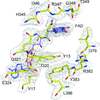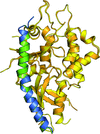issue contents
October 2017 issue

Cover illustration: Crystal structure of type II NADH:quinone oxidoreductase from Caldalkalibacillus thermarum with an improved resolution of 2.15 Å (Nakatani et al., p. 541).
research communications
The highest resolution structure of bacterial type II NADH:quinone oxidoreductase was determined at 2.15 Å resolution. This structure was used for in silico quinone substrate-docking studies to investigate the binding poses of menadione and ubiquinone molecules.
PDB reference: type II NADH dehydrogenase, 5wed
The crystal structure of the starch-binding domain of glucoamylase shows that the conformation of the region surrounding the disulfide bond is highly flexible.
PDB reference: starch-binding domain of glucoamylase, 5ghl
The expression, large-scale crystallization and neutron diffraction analysis of the human HSP70 ATPase domain are reported.
Structural information on the 607-amino-acid human ATG16L1 protein is restricted to the N-terminal ATG5-binding domain and the recently reported structure of the C-terminal WD40 domain, whereas structural information for the central region of ATG16L1 remains elusive. In this work, the identification, purification, biochemical characterization and crystallization of a stable ATG16L1 subfragment comprising residues 72–307, comprising the so far structurally uncharacterized central region of ATG16L1, are presented.
Open  access
access
 access
accessVirus-like particles (VLPs) from Norovirus Chiba strain were crystallized and data were collected to 3.2 Å resolution. X-ray analysis revealed that although 38 nm VLPs with T = 3 symmetry had been prepared for crystallization, the crystal contained 23 nm VLPs with T = 1 icosahedral symmetry.
Crystallization conditions for a pharmaceutical protein were optimized using a microfluidic platform and X-ray data were collected both in situ and ex situ.
The thermostabilities, hydrolytic properties and crystal structures of the OXA-48-like class D β-lactamases OXA-163, OXA-181 and OXA-245 have been investigated.


 journal menu
journal menu



















![[publBio]](/logos/publbio.gif)





